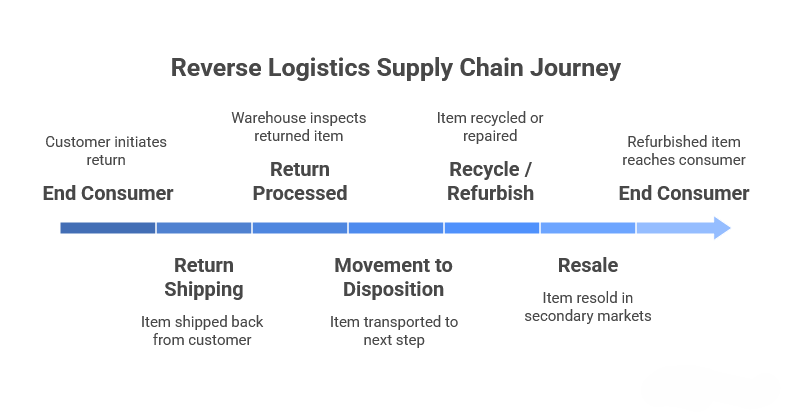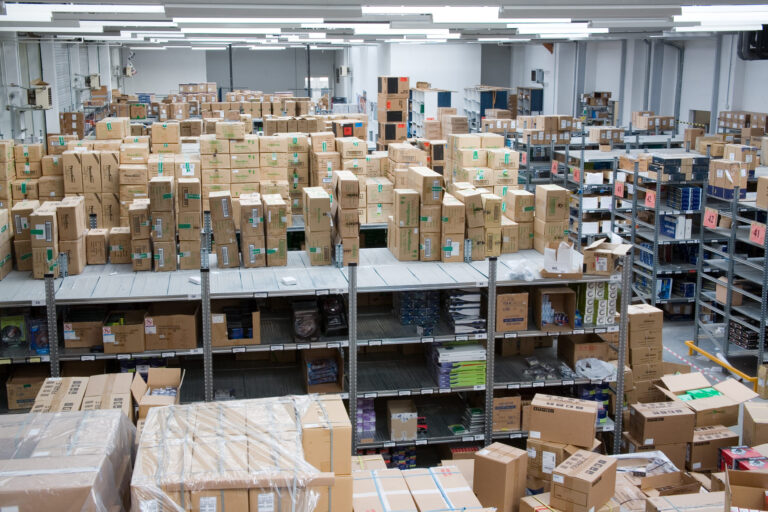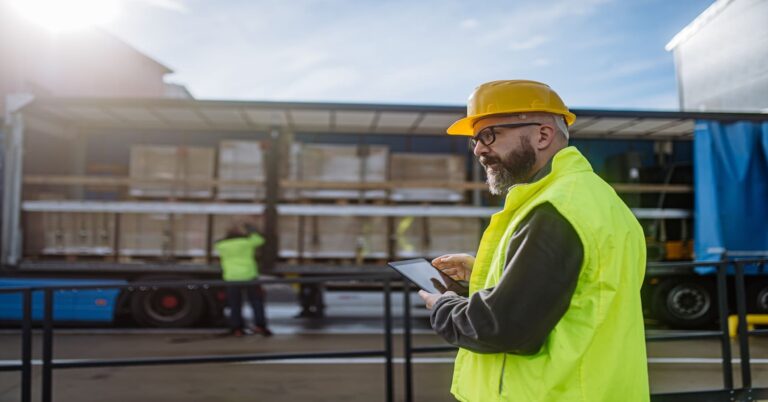Reverse Logistics in E‑Commerce: Turning Returns into Opportunities

Why E‑Commerce Returns Are a Growing Challenge
The explosion of online shopping has led to record volumes of returns. U.S. customers sent back $890 billion worth of products in 2024 alone, and industries such as fashion regularly see return rates of 30–40 %. Online orders are returned at a much higher rate than in‑store purchases, about 20 % of e‑commerce purchases compared to 8‑10 % for brick‑and‑mortar. Each return costs retailers an average of $20–$30 in handling, inspection and restocking, which can eat up to 7 % of gross sales. Beyond the direct costs, fraudulent returns account for $103 billion in losses annually and cause operational strain.
The hidden costs of returns
- Operational bottlenecks: During peak seasons, inbound returns compete for warehouse space and labor, delaying order fulfillment.
- Inventory issues: Returned products may be out‑of‑season or devalued, forcing retailers to discount or liquidate them.
- Environmental impact: Returns generate an estimated five billion pounds of landfill waste annually, and a quarter of all returned items end up in landfills.
- Customer loyalty: A poor return experience discourages 95 % of buyers from purchasing again, while 67 % read return policies before buying.
Understanding Reverse Logistics
Reverse logistics is the process of moving goods from the customer back to the seller or manufacturer for reuse, refurbishment, resale or disposal. The Council of Logistics Management defines it as the “process of implementing, controlling and planning the cost‑effective flow of finished goods, raw materials and inventory from the point of consumption back to the point of origin”. In e‑commerce, this includes returns management, recycling of packaging, refurbishment of defective products and trade‑ins.

Reverse logistics vs. forward logistics
Forward logistics moves products from manufacturers to customers; reverse logistics flows in the opposite direction to recapture value or dispose of items. Key differences include direction (outbound vs. inbound), objectives (fulfilling demand vs. recovering value) and complexity, returns are far less predictable and often more complex to manage.
Components of reverse logistics
- Returns management: Accepting, inspecting and processing returned items; generating return merchandise authorizations (RMAs).
- Refurbishment and repair: Restoring items for resale or reuse; cannibalizing parts when necessary.
- Repackaging and restocking: Cleaning, repackaging and returning items to inventory; recapturing value from open‑box goods.
- Recycling and disposal: Responsible disposal or recycling of goods that can’t be resold.
- Return policy and procedures: Clear and consistent policies that set customer expectations.
- Data collection: Capturing reasons for returns to identify product or process issues and reduce future returns.
Market size and growth
The global reverse logistics market was valued at $993 billion in 2023 and is projected to grow at 10.34 % annually through 2032. Worldwide returns reached $1.8 trillion in 2022, indicating both the scale of the challenge and the opportunity for value recovery.
Why Reverse Logistics Matters for Your E‑Commerce Business
A well‑designed reverse logistics program turns costly returns into opportunities.
- Enhances customer experience: Hassle‑free returns build trust and loyalty. Digital return portals let customers initiate returns, print labels and track refunds in real time. Buy‑online‑return‑in‑store (BORIS) programs appeal to 62 % of customers who want store returns, eliminate shipping costs and enable immediate restocking.
- Recovers value: Refurbishing, repackaging and reselling returned products can recover up to 65 % of a returned item’s value, compared with ~30 % for companies without optimized processes. Secondary markets and certified refurbished programs (e.g., Apple’s program which saved 330,000 tons of e‑waste and generated $4 billion) illustrate how returns can become profit centers.
- Supports sustainability: Reusing and recycling products reduces waste and emissions. Circular economy practices like refurbishing and resale cut landfill waste by up to 40 %. Consumers increasingly reward brands that adopt sustainable reverse logistics.
- Provides data insights: Returns reveal product issues, packaging problems and customer preferences. Analysing return reasons helps reduce future returns, improve product design and forecast demand.
Strategies and Solutions for Effective Reverse Logistics
Modern solutions span technology, partnerships and policy improvements. The table below summarises common reverse logistics solutions and their benefits.
| Solution | How it Works | Key Benefits |
|---|---|---|
| Digital Returns Portals | Customers initiate returns online, receive pre‑paid labels or QR codes and track refunds. | Faster returns, better customer experience, real‑time visibility, lower manual errors. |
| Technology‑Driven Warehouses | Automated sorting, inspection and repackaging systems speed up processing and reduce labour costs. AI predicts return volumes and routes items efficiently. | Higher accuracy, faster turnaround, lower labour costs. |
| 3PL Reverse Logistics Partners | Outsourcing returns management to specialised logistics providers who handle transportation, inspection and restocking. | Cost efficiency, scalable operations and access to expertise, particularly valuable for SMEs. |
| AI & Data Analytics | Machine‑learning models predict return rates, detect fraud and optimise disposition routes. | Reduced fraud losses, improved recovery rates, better inventory planning. |
| Omnichannel Returns | Allow customers to return online purchases in store or via pickup/drop‑off networks. | Enhances convenience, shortens return cycle, boosts foot traffic. |
| White Glove and Premium Services | In‑home pickups, assembly/disassembly and personalized return handling. | Improved customer satisfaction and brand differentiation. |
Best Practices to Reduce Returns and Optimise Reverse Logistics
- Develop clear return policies: Transparent policies reduce fraud and set customer expectations. Include timelines, condition requirements and return options.
- Leverage digital tools: Use branded online return portals to collect return reasons, generate labels and update inventory immediately.
- Integrate systems: Connect your e‑commerce platform, warehouse management system (WMS) and inventory systems to track returned items in real time.
- Offer try‑before‑you‑buy tools: Virtual try‑ons, sizing guides and detailed product descriptions reduce the likelihood of bracketing and size‑related returns.
- Use smart packaging: Design packaging that can be reused for returns. Sustainable packaging reduces environmental impact and shipping costs.
- Train staff and establish SOPs: Ensure consistent inspection, refurbishment and restocking procedures.
- Monitor return metrics: Track return rates by SKU, customer segment and return reason. Identify high returners and adjust marketing accordingly.
- Partner with 3PLs for scale: Outsourcing to specialist providers can lower costs and improve turnaround times.
- Adopt AI and automation: Implement fraud detection tools, predictive analytics and robotic systems to cut costs and speed up processing.
- Embed sustainability: Prioritise recycling and resale over disposal. Promote refurbished products to eco‑conscious consumers and join circular‑economy initiatives.
Emerging Trends and the Future of Reverse Logistics
Looking ahead, several trends will shape reverse logistics through 2025 and beyond:
- Automation and robotics: Flexible automation is enabling robots to handle a wider variety of parts, reducing labour costs and improving accuracy.
- AI‑powered forecasting and fraud detection: Machine‑learning models will predict returns and detect fraudulent patterns, reducing the $103 billion lost to fraud each year.
- Premium return services: White glove returns, smart return hubs and dark stores will offer faster, more personalised experiences.
- Sustainable and circular practices: Programs like Patagonia’s Worn Wear and Apple’s Certified Refurbished demonstrate the revenue potential of refurbishment. Expect greater emphasis on recycling, reuse and eco‑friendly packaging.
- Real‑time data and analytics: Cloud‑based platforms will provide visibility into return status, enabling proactive restocking and customer communication.
- Global regulations and ESG pressure: Extended Producer Responsibility (EPR) and WEEE directives will push businesses to manage end‑of‑life products responsibly.
Conclusion
Returns are an unavoidable part of e‑commerce, but they don’t have to be a cost centre. By implementing a strategic reverse logistics program-built on clear policies, digital tools, integrated systems, and partnerships-retailers can recoup value, reduce waste and delight customers. The market for reverse logistics is booming, and companies that invest in automation, AI and sustainable practices will turn returns into a competitive advantage.
Frequently Asked Questions (FAQ) – OLIMP Warehousing
Q: What is reverse logistics in e‑commerce?
Reverse logistics refers to the process of moving goods from customers back to sellers or manufacturers. In e‑commerce, it involves accepting returned products, inspecting them, repairing or refurbishing where necessary, repackaging and restocking or recycling.
Q: What are two benefits associated with reverse logistics?
First, it allows companies to recover value from returned products by refurbishing and reselling them—sometimes recovering up to 65 % of a product’s value. Second, efficient reverse logistics improves customer satisfaction and loyalty by providing hassle‑free returns.
Q: How does reverse logistics contribute to sustainability?
Reverse logistics encourages reuse, refurbishment, recycling and responsible disposal. Circular practices can divert up to 40 % of returns from landfills and reduce the five billion pounds of waste generated by returns each year.
Q: How can I improve reverse logistics in my online store?
Introduce digital return portals for easy label printing and tracking, refine return policies, gather data on return reasons, integrate your systems, use sustainable packaging and partner with 3PL experts. AI‑based tools can predict returns and detect fraud, lowering costs.
Q: Which return method is most customer‑friendly?
Buy‑online‑return‑in‑store (BORIS) appeals to 62 % of shoppers and eliminates shipping costs, while digital return portals offer convenience and real‑time tracking. Offering both options meets diverse customer preferences.
You may be interested in

Backorder vs Out of Stock: Meaning, Differences & Management Strategies
Backorder vs Out of Stock – these two terms can be a source of confusion for consumers and a critical decision point for businesses. If you’ve ever tried to buy something online and seen it listed as “out of stock,” you know the disappointment of not being able to order it. On the other hand, […]

Best 3PL Warehouse for Your TikTok Shop Fulfillment
TikTok Shop sellers often face sudden viral demand. A specialized 3PL (third-party logistics) partner helps by handling warehousing, order picking, packing, shipping, and returns. This article explains why TikTok sellers need dedicated TikTok fulfillment services and what features to look for in a TikTok fulfillment center. Why TikTok Sellers Need a Specialized 3PL Fulfillment Company […]

Best Practices for Warehouse Receiving Processes
Warehouse receiving is the essential first step of warehouse operations – it encompasses everything from unloading inbound deliveries to updating inventory records. In practice, an effective warehouse receiving process means checking in, inspecting, and storing all incoming goods promptly and accurately. How inventory is received at a warehouse sets the tone for the rest of […]
Ready to streamline your warehousing needs?
Request a quote today and discover how OLIMP's tailored solutions can optimize your operations